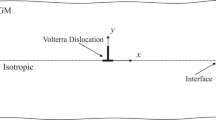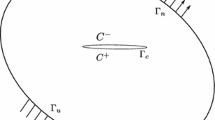Abstract
A refined optimal method consisting of the tandem application of frozen stress photoelasticity and high density moire interferometry for studying three dimensional effects in cracked bodies is briefly reviewed. It is then employed to measure the dominant eigenvalue at the right angle intersection of a straight front crack with a free surface under mode I loading. The variation of the eigenvalue through a transition zone near the free surface is also determined. The free surface result is found to be in agreement with analytical results.
Résumé
On expose brièvement une méthode optique consistant à appliquer en parallèle la photo-élasticité sous contraintes figées et l'interférométrie sur bandes de Moiré à hautes densités, pour l'étude des effets tridimensionnels dans les solides fissurés. On utilise ensuite cette méthode à la mesure de l'eigenvalue dominante à l'intersection suivant un angle droit d'un front de fissure droit avec une surface libre, sous une sollicitation de Mode I. On détermine également la variation de l'eigenvalue dans une zone de transition au voisinage de la surface libre. Le résultat relatif à cette dernière est en bonne concordance avec les résultats analytiques.
Similar content being viewed by others
References
M.L. Williams, Journal of Applied Mechanics 24 (1957) 109–114.
C.W. Smith, in Experimental Techniques in Fracture Mechanics 2, Society for Experimental Stress Analysis, A.S. Kobayashi (ed.) (1975) 3–58.
C.W. Smith, in Mechanics of Fracture, Vol. 7, G.S. Sih (ed.) Martinus-Nijhoff (1981) 163–187.
C.W. Smith and A.S. Kobayashi, in Handbook on Experimental Mechanics, A.S. Kobayashi (ed.) Society for Experimental Mechanics, Prentice Hall, Inc. (1987) 891–956.
G. Oppel, Forsch. Geb. Ingenieurw. 7 (1936) 240–248.
C.W. Smith, Journal of Experimental Mechanics 20, No. 4 (1980) 126–133.
R. Weller and B.M. Shepard, Proceedings of Society for Experimental Stress Analysis VI, No. 1 (1948) 35–38.
J. Eftis, N. Subramonian, and H. Liebowitz, Journal of Engineering Fracture Mechanics 19, No. 1 (1977) 189–210.
G.C. Sih, International Journal of Fracture Mechanics 7, No. 1 (1971) 39–62.
E.S. Folias, Journal of Applied Mechanics 42, Series E, No. 3 (1975) 663–672.
J.P. Benthem, International Journal of Solids and Structures 16 (1980) 119–130.
W.S. Burton, G.V. Sinclair, J.A. Solecki, and J.L. Swedlow, International Journal of Fracture 25 (1984) 3–32.
C.W. Smith and J.S. Epstein, in Proceedings of Vth International Congress on Experimental Mechanics, June 1984, 102–110.
C. Ruiz and J.S. Epstein, International Journal of Fracture 28 (1985) 231–238.
C.W. Smith and M. Rezvani, Proceedings of a Joint International Conference of the British Society for Strain Measurement and the Society for Experimental Mechanics, August 1987, in press.
Author information
Authors and Affiliations
Rights and permissions
About this article
Cite this article
Smith, C.W., Epstein, J.S. & Rezvani, M. Measurement of dominant eigenvalues in cracked body problems. Int J Fract 39, 15–24 (1989). https://doi.org/10.1007/BF00047436
Received:
Accepted:
Issue Date:
DOI: https://doi.org/10.1007/BF00047436




